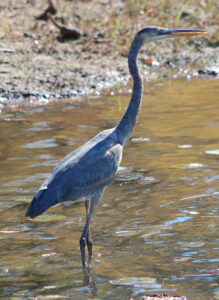The Great Blue Heron, Patient Hunter
I don’t remember when I first encountered this magnificent bird. But it left a lasting impression, so much so that I made it part of my company’s logo.
Standing 38-43 inches high and boasting a wingspan of six feet, it’s hard to miss. The blue part of its name is a bit confusing much like a Purple Finch that looks red, or a Red-bellied Woodpecker whose belly is a very faint rusty color. The Great Blue Heron’s coloration is mostly slate-gray with some black and brown accents. This is the largest and most widespread heron in North America, so it’s a good chance you may have seen it. In flight they look quite different, holding their head close to their body with a bent neck, but still an awesome sight to behold.
You commonly find great blues near marshes, mud flats, lakes, and other shallow water areas, spending their time in a frozen stance, waiting for prey to happen along. They nest colonially in trees near water and then disperse to feeding areas. Nesting colonies are typically found in mature forests, on islands, or near mudflats. Great Blue Herons do best when they are free of human disturbance (duh) and have easy access to foraging areas near by.
Great Blue Herons typically breed in colonies anywhere from a few to several hundred pairs. Nest building begins when a male chooses a nesting territory and actively displays to attract a female. The large nest is usually built high up in a tree out of harm’s way. The parents work together to build the nest. The male gathers sticks and the female constructs a platform nest lined with small twigs, bark strips, and pine needles. Both parents take turns incubating the eggs for about 4 weeks. Then, after hatching, the parents bring food to their young for two months until they can fly. But they still continue feeding the birds for a few weeks after fledging (leaving) the nest.
The Great Blue Heron is not a picky eater and will feed on fish, amphibians, reptiles, invertebrates, small mammals such as voles, and even other birds. They stalk their prey slowly and deliberately. When foraging, they stand silently and unmoving along the shore, waiting for prey to come by. Then, in the blink of an eye, they stab their meal with a quick lunge of the bill.
 To the human eye, the actual capture appears instantaneous. But in truth, the heron waits very long and in stillness before the catch. Here he teaches us the value of patience, of observing with a keen eye, and not wasting time when the opportunity arises.
To the human eye, the actual capture appears instantaneous. But in truth, the heron waits very long and in stillness before the catch. Here he teaches us the value of patience, of observing with a keen eye, and not wasting time when the opportunity arises.
Several Native American Tribes look at the heron as a symbol of patience and good luck. On the Northwest coast, people believe that if Native American fishermen spot a heron, it means good luck is with them, and they will have a successful fishing trip.
I believe that’s true. Nature, in the form of a Great Blue Heron, is my guide.
Ross A. Feldner, RCC Board Member
 Ross Feldner is the lead, with Bob Musil, of the RCC Bird Watch and Wonder Program. Ross is a life-long birder and photographer who is the editor of the Friends of Patuxent National Wildlife Refuge newsletter. Ross also serves as a guide at the Patuxent National Wildlife Refuge, a frequent birding spot for Rachel Carson who first learned about the health effects of DDT at the laboratory there. He is also the owner/art director of New Age Graphics, a full-service graphic design firm in Wheaton, MD.
Ross Feldner is the lead, with Bob Musil, of the RCC Bird Watch and Wonder Program. Ross is a life-long birder and photographer who is the editor of the Friends of Patuxent National Wildlife Refuge newsletter. Ross also serves as a guide at the Patuxent National Wildlife Refuge, a frequent birding spot for Rachel Carson who first learned about the health effects of DDT at the laboratory there. He is also the owner/art director of New Age Graphics, a full-service graphic design firm in Wheaton, MD.
![]() The Rachel Carson Council depends on tax-deductible gifts from concerned individuals like you. Please help if you can.
The Rachel Carson Council depends on tax-deductible gifts from concerned individuals like you. Please help if you can.
![]() Sign up here to receive the RCC E-News and other RCC newsletters, information and alerts.
Sign up here to receive the RCC E-News and other RCC newsletters, information and alerts.









